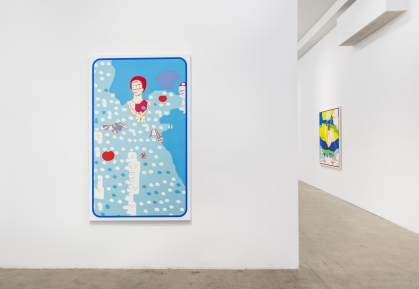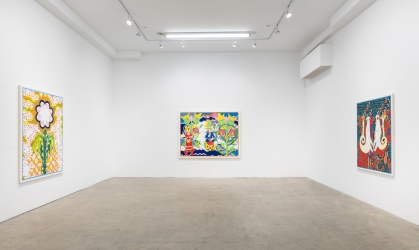Faculty Artist Combines Folk Art with Artificial Intelligence to Question Public Memory
Stass Shpanin, a visual artist and associate teaching professor of art in Rutgers University–Camden’s Department of Visual, Media, and Performing Arts, explores mythologies and reinterpretations of American history through imagery rooted in 18th- and 19th-century Americana folk art.
He has recently presented a solo exhibition, Forbidden Garden, at the gallery PLATO on New York’s Lower East Side, and concurrently, has been featured in the Delaware Contemporary Art+AI Biennial exhibition, which explores the theme of artificial intelligence (AI) in the arts.
“I am interested in the place where the imperfections of memory encounter the inadequacies of documentation,” said Shpanin. “I want the viewer to be left alone on the stage where known history and cultural memory melt to experience a psychophysical sense of displacement.”

Stass Shpanin
Exploring interpretations of the past as they reverberate in the present, Shpanin, a Philadelphia-based artist, combines centuries-old American folk imagery with artificial intelligence technology on hand-painted canvases to deconstruct civic myth-making while examining the visual mechanisms that affect public memory.
Shpanin, whose practice pushes against the boundaries of code, culture, and contemporary painting, is quick to emphasize that the end products of his AI explorations are always presented on hand-painted canvases. Through this process, AI is used as a tool that provides a means to an end.
“AI will not spell the end of individual artists or creators,” Shpanin said. “People thought the invention of photography would put an end to figurative painting.
“That hasn’t happened. For me, there is a commitment to painting. What I do with AI is experiment. Those experiments go through many iterations before I land on what I want to present as a final image.”

Stass Shpanin
Much of Shpanin's work is inspired by folk-art drawings known as “fraktur.” Dating back to the 18th and 19th centuries, these pieces include elaborate and colorful depictions of birds, flowers, hearts, unicorns, and more. Immigrants to America from Switzerland, Germany, and France were known to have created fraktur imagery to commemorate important events. Today, fraktur images are recognizable to anyone familiar with the regional art of the Pennsylvania Dutch, particularly throughout Lancaster County and beyond.
To create these paintings, Shpanin first chooses imagery from fraktur, then digitally breaks the illustration down, creating new compositions that often contain glitches from the technology he uses.
An immigrant to the United States, Shpanin was born in Azerbaijan—formerly the Soviet Union—and has lived in America since he was a teenager. He is no stranger to ideological changes within nations and the imagery associated with these historical transformations. The art displayed in Forbidden Garden combines images of the birds, animals, and plants found in many states and municipalities’ insignia, flags, and official documents; their meanings are often similar but adjusted by Shpanin to fit a particular context.
Shpanin admits to being a disruptor who is fascinated by early American imagery. “Only through presenting fractured images can I provoke questions about myth and history,” he said. “I deliberately expose viewers to illusions of documentation and memory.”
关于《Faculty Artist Combines Folk Art with Artificial Intelligence to Question Public Memory》的评论
暂无评论